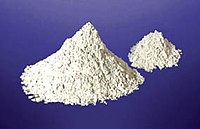
Photo from wikipedia
Functional metacomposites towards negative dielectric properties via percolating behavior have triggered tremendous fundamental and practical interest. In this paper, titanium nitride was selected to construct percolating metacomposites. Hence, adjusting the… Click to show full abstract
Functional metacomposites towards negative dielectric properties via percolating behavior have triggered tremendous fundamental and practical interest. In this paper, titanium nitride was selected to construct percolating metacomposites. Hence, adjusting the frequency region and the value of negative permittivity was effectively realized by uniformly building different ratio x of nickel(II) oxide/titanium nitride composites. Occurrence of percolation phenomenon and change of conductive mechanism were observed when alternating the ratio x. Two different types of negative permittivity (i.e., dipole-type and plasma-type) were observed in the composites. The dipole-type negative permittivity behavior in the composite with low titanium nitride content (i.e., x = 0.5) was ascribed to the resonance-induced electric dipole generated from the isolated titanium nitride particles, which could be explained by Lorentz model. While the plasma-type negative permittivity with titanium nitride content exceeding the percolation threshold could be well explained by the low frequency plasmonic state generated from conductive titanium nitride networks using Drude model. Besides, the electrical properties influenced by percolating phenomenon including ac conductivity, dielectric loss, and impedance were investigated. This work presents a systematic and novel investigation on negative dielectric properties of percolating metacomposites and will greatly facilitate the practical applications of metacomposites.
Journal Title: Journal of Materials Science: Materials in Electronics
Year Published: 2018
Link to full text (if available)
Share on Social Media: Sign Up to like & get
recommendations!